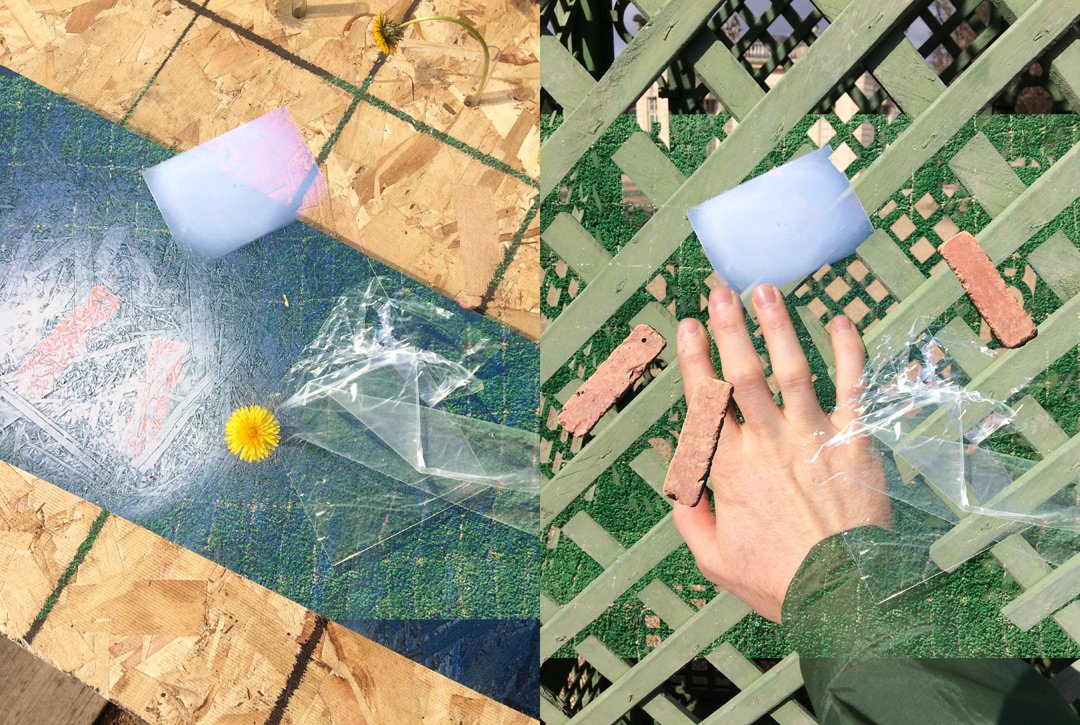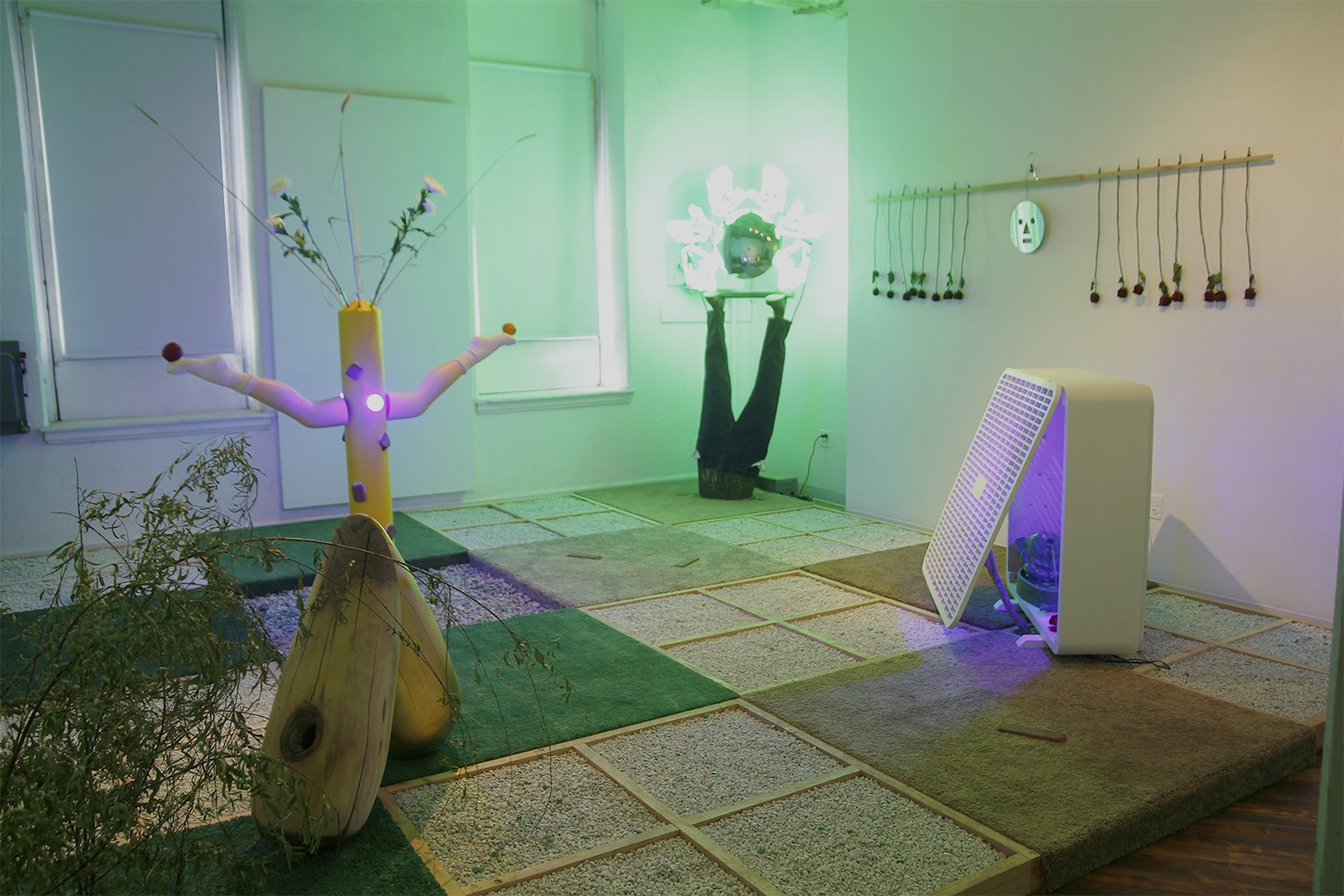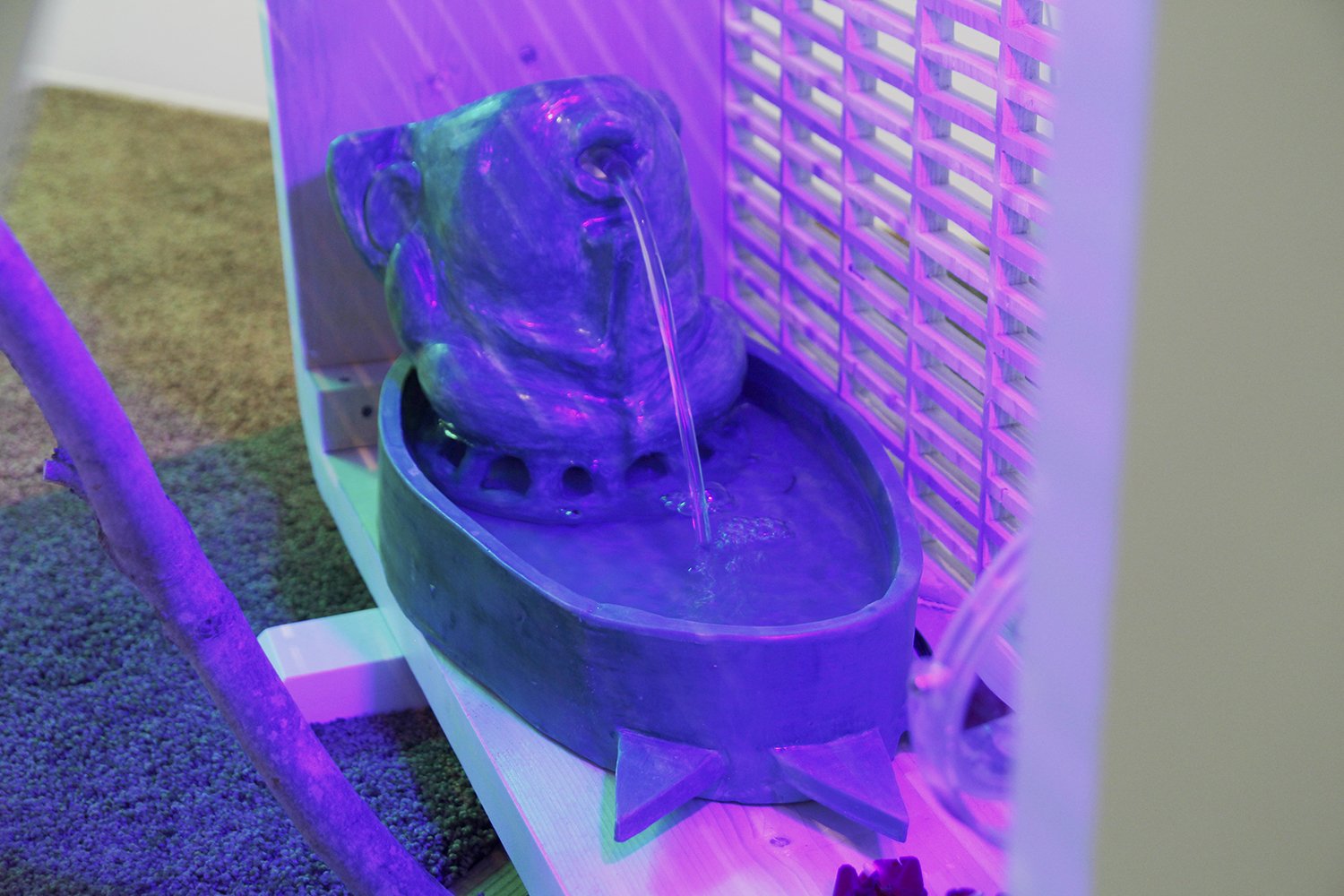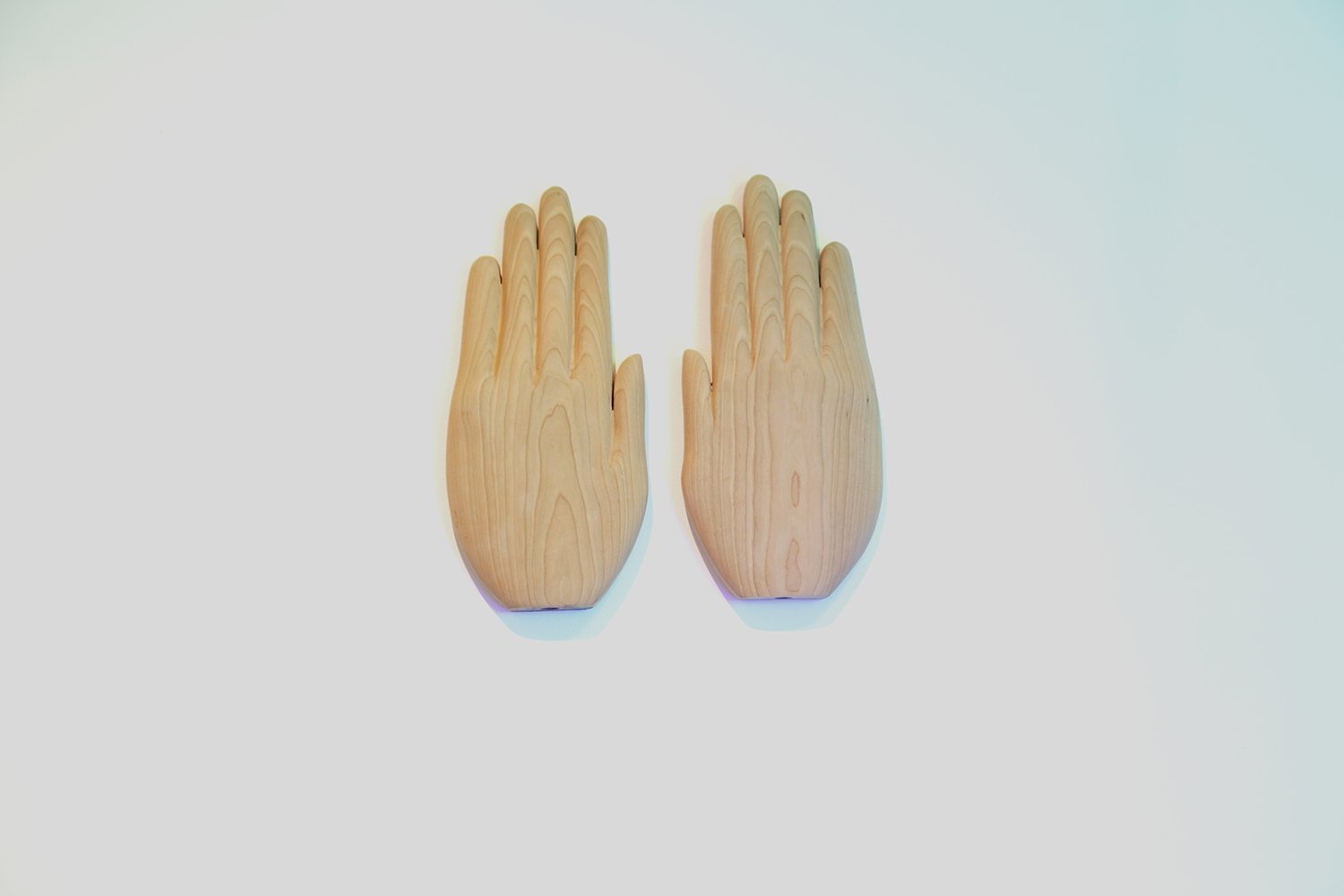Not Bearing but Born: Kasey Toomey
June 2017On view June 2nd – July 2nd, 2017Opening Reception: First Friday, June 2nd, 6pm – 10pm Happiness can still be found, even when the world seems to be burning from the inside out. Joy can still be found, manufactured, even cultivated. Joy, love, democracy, pessimism, pain, luck…. all require cultivation. All require a bodily presence.A garden requires a bodily presence for it to maintain itself as a garden and not become something other, such as natural or wild even. The garden is stuck in the collapse of the beginning and the end. It is both joyful and pessimistic. The garden is anthropologically where our human values have been consciously and subconsciously put on display and analyzed by following cultures and generations. A garden not only expresses human values and points of view, but also our relationship to the other, which could be the environment, gods, enemies, or neighbors. It is both mirror and lens. This construction couldn’t be more relevant in our current time and time going forward. Kasey Toomey is a multi-disciplinary artist and designer based in Philadelphia. He is pursuing an MFA at the University of Pennsylvania and is currently a resident artist on a private farm in New Jersey. Toomey has been a resident artist at RAIR and the Vermont Studio Center. He has participated in group exhibitions at High Tide, Tiger Strikes Asteroid, Little Berlin, and Delaware Center for the Contemporary Arts.
Happiness can still be found, even when the world seems to be burning from the inside out. Joy can still be found, manufactured, even cultivated. Joy, love, democracy, pessimism, pain, luck…. all require cultivation. All require a bodily presence.A garden requires a bodily presence for it to maintain itself as a garden and not become something other, such as natural or wild even. The garden is stuck in the collapse of the beginning and the end. It is both joyful and pessimistic. The garden is anthropologically where our human values have been consciously and subconsciously put on display and analyzed by following cultures and generations. A garden not only expresses human values and points of view, but also our relationship to the other, which could be the environment, gods, enemies, or neighbors. It is both mirror and lens. This construction couldn’t be more relevant in our current time and time going forward. Kasey Toomey is a multi-disciplinary artist and designer based in Philadelphia. He is pursuing an MFA at the University of Pennsylvania and is currently a resident artist on a private farm in New Jersey. Toomey has been a resident artist at RAIR and the Vermont Studio Center. He has participated in group exhibitions at High Tide, Tiger Strikes Asteroid, Little Berlin, and Delaware Center for the Contemporary Arts.
Inside Not Bearing but Born: Q & A with artist Kasey Toomey and Practice member, LeighAnn Bogner
 Can you explain your title for the show- Not Bearing but Born and its reference to the Statue of Liberty?Sure. The title is a phrase that struck me while viewing a documentary on the design and construction of the Statue of Liberty. Engineers were referencing the steel scaffolding inside the statue. The object that appears in front of us, the copper skin panels, are hung from the structure. She is floating, not standing.The creation of this installation was in process both before and after the election, did the current political climate alter the progression of this exhibition for Practice?In some sense it did force me to change course conceptually. I was laying the groundwork for a series of sculptures that was related to some studio research I was doing. Once the election happened I decided I needed to shelve that work I was doing and work with that torment. I just kept coming back to the idea of a garden and wanting to be in a garden and if one could gather that feeling of pessimism, but at that same time a belief in excellence, but at the same time feeling guilty for even believing in the idea of excellence, but at the same time something tragic, but at that same time wanting to still be beautiful. That series of conflictions sums up the tension held within a garden. A garden, like a democracy, requires constant attention and bodily effort to maintain it as the thing you thought it ought to be. The body is part of the content for each work within the installation. I also just thought maybe the sweet scent of honeysuckle couldn’t be as comforting and jarring as it could be right now. How does your landscape architecture and botany past inform your art work?It informs everything from space to material to content. Most of my work is rooted in that history, which is other than ‘art’ or ‘sculpture’. This installation in fact has made me more comfortable with that realization. My work is rooted in some aspect of the landscape whether it be the everyday, designed, natural, urban, rural, manufactured, and anything else on the spectrum. The landscape is where differences come together and the landscape is where walls are built.
Can you explain your title for the show- Not Bearing but Born and its reference to the Statue of Liberty?Sure. The title is a phrase that struck me while viewing a documentary on the design and construction of the Statue of Liberty. Engineers were referencing the steel scaffolding inside the statue. The object that appears in front of us, the copper skin panels, are hung from the structure. She is floating, not standing.The creation of this installation was in process both before and after the election, did the current political climate alter the progression of this exhibition for Practice?In some sense it did force me to change course conceptually. I was laying the groundwork for a series of sculptures that was related to some studio research I was doing. Once the election happened I decided I needed to shelve that work I was doing and work with that torment. I just kept coming back to the idea of a garden and wanting to be in a garden and if one could gather that feeling of pessimism, but at that same time a belief in excellence, but at the same time feeling guilty for even believing in the idea of excellence, but at the same time something tragic, but at that same time wanting to still be beautiful. That series of conflictions sums up the tension held within a garden. A garden, like a democracy, requires constant attention and bodily effort to maintain it as the thing you thought it ought to be. The body is part of the content for each work within the installation. I also just thought maybe the sweet scent of honeysuckle couldn’t be as comforting and jarring as it could be right now. How does your landscape architecture and botany past inform your art work?It informs everything from space to material to content. Most of my work is rooted in that history, which is other than ‘art’ or ‘sculpture’. This installation in fact has made me more comfortable with that realization. My work is rooted in some aspect of the landscape whether it be the everyday, designed, natural, urban, rural, manufactured, and anything else on the spectrum. The landscape is where differences come together and the landscape is where walls are built.
You have a lot going on in the gallery! There are some very subtle and almost hidden parts of the installation. Is it important to you that the viewer notice these?I enjoy putting details into my work that aren’t necessarily apparent at first glance or read. Richness is definitely something I am trying to achieve and that I am consciously thinking about. I am always hoping to create an openness in my work that allows for ways in and for ways out for the most varied of audiences. It is this vague specificity that we all operate with and use to break down the world into decipherable parts that relate to ourselves. It is my hope that one can notice a new detail upon repeated viewing. Do you consider this installation participatory?On some level I do. It is as participatory as a garden is participatory. A garden presents a viewpoint and one can occupy it and take in that viewpoint, but you aren’t actively changing that viewpoint. A public open space offers a completely different level of participation in that the occupiers or those that take claim of that space are providing the point of view to some degree. Same goes for a democracy. The appearance of freedom and the concealment of control are important factors in a successful democracy and public open space. The floor of the gallery was a very important aspect for me because I wanted one to have an awareness and uneasiness about their body within the space and when they approached the sculptural objects. Most of the sculptural works within the installation bring the body of the viewer into the work. The oversized box fan sculpture, Hot Air Blowing in the Wind, has a ceramic Statue of Liberty head functioning as a fountain inside of it. The handmade grills of the box fan make it difficult to see her inside from most viewing angles. You can only see her well from far away or if you bend down close to the sculpture to peek inside. But you do always hear her wherever you are within the installation. The green neon and wood sculpture, Trickle Down Economics, features a circular mirror. It is very satisfying for your vanity to view your face in the mirror washed in green light. However, it is nearly impossible to take a photo of yourself in that moment. I love that the moment can only really live there in the present. 
I know your wood and gold-leafed sculpture, Vinnie Venus, has some prehistoric origins for you. Could you speak to the symbolism within the sculpture?I really wanted an object to greet you as one entered the space that had a very prehistoric or primordial presence. I’ve personally been fascinated with sculptural forms that were made prior to our contemporary or even ancient understanding of sculpture. For the same reasons, I am very fascinated with the symbolism within cave paintings. To me they are as natural as a stand of sassafras trees is natural. Prehistoric fertility sculptures, such as the Venus of Willendorf, are often these small carvings of a woman or womanlike figure with voluptuous features. I carved this sculpture from two different types of wood, maple and walnut, into a form that is meant to be more primordial in sexuality. We all came from the same place. We are all going to the same place. The feeling of oneness and the formal appearance that it is of the body as you entered was important to set the stage for the rest of the installation. The sculpture is backed by a swath of willow cuttings, Salix babylonica. Willow is powerful tree in terms of religious symbolism in addition to its ecological role. Willows take up heavy metals from contaminated soils. They require a lot of water, so they are a sign that life sustaining water is nearby. They also hold streambanks together from the destructive forces of the same life sustaining water. What type of rules and guidelines do you set for yourself while curating the different aspects of a space? How did you decide when this installation was complete? I had a game plan for how I was to install this work and for the most part I stuck to it. I wanted the body to ramble and stumble from each piece. I had a plethora of things I made for this installation that didn’t make it in because they impeded the ramble. They will make their way into different things that I do in the future. I find that is often how I work, in that I pull back at the very last second. I personally know it is from my architectural background. I live and die for a deadline. It’s forced me to believe that you should continue working until the last second because things aren’t done until they are done. What is your workspace like? Any rituals you have when you do art?My workspace is always centered around my maple workbench I made myself and sized to my body. It’s a beautiful object in its own right and useful, but it’s also a reminder to stay engaged with the craft of making. Some of my work starts from a preexisting object, so collecting and keeping objects around is important to how I work. Searching for an object or material to fulfill a role is completely different than serendipitously finding a strange relationship between things you have had sitting around for a while. Allowing your mind to do some subconscious work is the payoff for lugging your growing collection of bricks and obscenely heavy construction materials around your studio.
